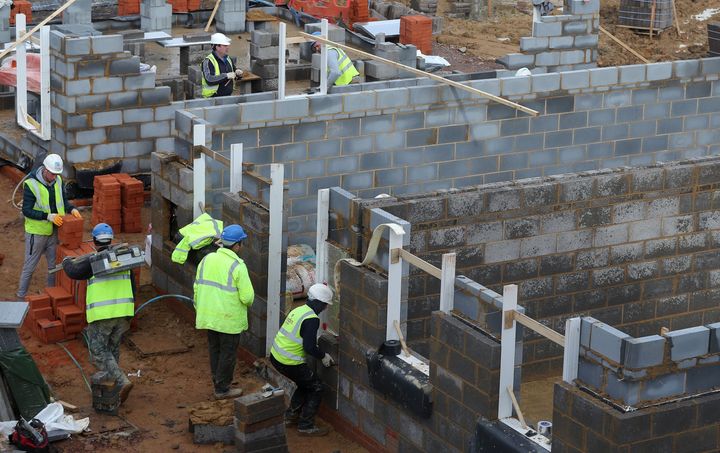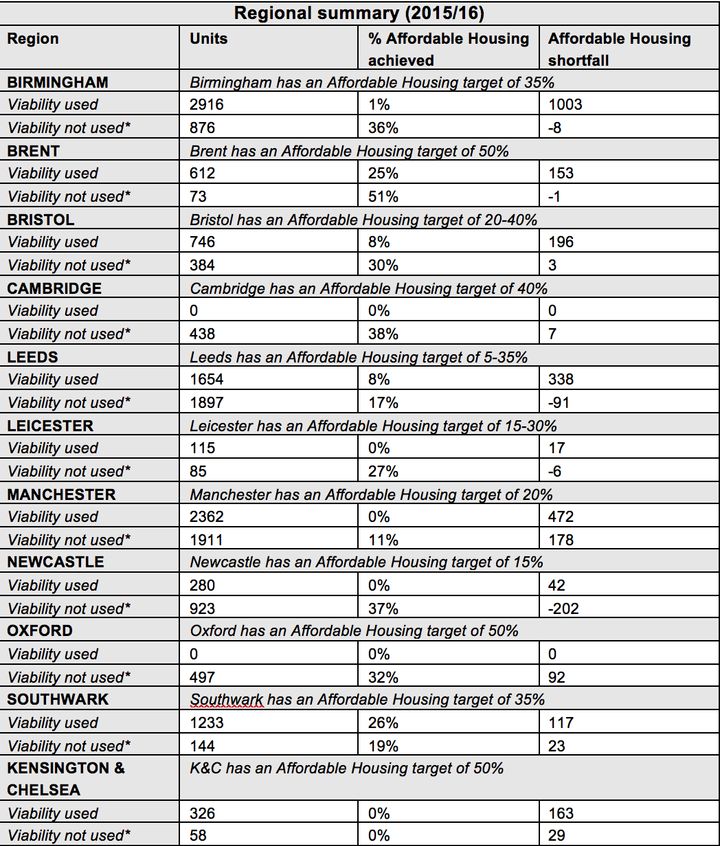
House builders are using a “legal loophole” to wriggle out of developing thousands of affordable homes in order to maximise profits, a housing charity has claimed.
Shelter has released a dossier it claims shows the number of affordable homes in new-builds drops drastically after developers submit a “viability assessment” when applying for permission to build.
These assessments allow developers to put in planning applications which do not hit council targets for affordable homes – claiming if they were to build those houses it would mean profits would be severely reduced.
One council told HuffPost UK it feels it has no choice but to accept the lower affordable housing figure, or risk no development happening at all.
According to Shelter, at least 2,500 affordable homes across England were lost from developments thanks to these assessments.
The Home Builders Federation – whose members build 80% of new dwellings each year – furiously defended the actions of developers, saying affordable housing targets are not set in stone and planning applications are always negotiated with local authorities.
But Shelter’s chief executive, Polly Neate, called on the Government to act now to make sure that affordable housing is not being axed in new developments by house builders looking to maximise profits.
She said: “What this research reveals is the scale at which developers are able to use legal loopholes to protect their profits and dramatically reduce the numbers of affordable homes available for people.
“Through freedom of information powers, Shelter has been able to reveal the extent to which affordable homes are required in local plans, only to be dropped by developers.
“The government needs to fix our broken housing system – and it must start by closing this loophole to get the country building homes that are genuinely affordable for people on middle and low incomes to rent or buy.”
Councils put affordable home targets in their Local Plans, and it is against these that new planning applications are measured.
Yet the National Planning Policy Framework - produced by the Government - provides a loophole for developers to apply for permission to build new properties without hitting the target for affordable homes:
To ensure viability, the costs of any requirements likely to be applied to development, such as requirements for affordable housing, standards, infrastructure contributions or other requirements should, when taking account of the normal cost of development and mitigation, provide competitive returns to a willing land owner and willing developer to enable the development to be deliverable.
This get-out-clause means council’s often find themselves having to grant planning permission that does not meet their criteria, for fear any refusal would be overturned on nationally.
Shelter’s research focused on Birmingham, Brent, Bristol, Cambridge, Leeds, Leicester, Manchester, Newcastle, Oxford, Kensington and Chelsea, and Southwark, but as the assessments are being used right across the country, the annual figure of lost houses is likely far higher than the 2,500 identified.
The dossier shows that where viability was used in an application, only 7% affordable housing was achieved.
Where viability was not used, 24% affordable housing was achieved - still well off the targets these councils had put in their local plans.

Mark Williams, Cabinet Member for Regeneration and New Homes at Southwark Council in London, says his team always pushes “for the highest amount of affordable homes that we can achieve.”
But the Freedom of Information request from Shelter revealed that of the 1,233 units built in the borough in 2015/16, just 26% were affordable housing when viability assessments were used - against a target of 35%
Even when viability assessments weren’t used only 19% of the 144 units built were classed as affordable.
Williams said: “The reality for any council is that it’s easy to turn down planning applications, but developers can then appeal the decision, and what often happens is that agreements then go through with lower levels of affordable housing, or developers walk away and sites lay empty for years.
He added: “In March 2016 we adopted tough new rules for how viability assessments are treated. This includes full transparency, a clear approach to valuing land to suppress land speculation, and upwards only review mechanisms for any schemes that are consented below 35%.
“These are incredibly challenging circumstances for those of us trying to tackle the housing crisis, we need everyone including government, and all councils, to play their part in tackling the housing crisis.”
Brent Council, also in London, said developers are in a strong position as local authorities rely on them to build affordable housing – something many council’s do not have the money to do.
Harbi Farah, Brent Council’s Cabinet Member for Housing said: “Until the government stops land-banking and better funds local authorities, allowing councils like Brent to borrow money to build new homes, we are in a position where we need to work with developers to provide the homes that people need and that sometimes entails compromise.
“We do however always use viability assessments as an opportunity to maximise affordable housing, with two out of every three assessments in the past five years resulting in an increased contribution to affordable housing than initially proposed, while keeping the project viable.”
Of the other councils in the list, Oxford City Council said of the five developments for 10 or more dwellings in 2016/17 where 50% affordable housing was required, four of them hit the target.
The only site that did not was required to build 40% affordable housing instead due to “abnormal costs” relating to providing a new bridge, boatyard, works to the canal and contamination remediation.
“So, we are delivering affordable housing,” said a council spokesperson.
Kensington and Chelsea Council leader Elizabeth Campbell seemed to admit that viability reports led to more houses being built in developments, but not at affordable rates.
She said: “In places like Kensington and Chelsea, an independent viability report often results in the ability to build more homes, due to the sums of money developers have to pay instead of providing affordable housing on site.
“That said, we are getting tougher with developers to ensure that where affordable housing can be provided it is. Grenfell has focussed everybody’s minds on the issue of housing and we and we want to find solutions.”
A spokesperson for Newcastle City Council said they “rigorously scrutinise” any viability assessment, and also require another report to be carried out once the development has finished.
“If the scheme is proved to be more profitable, then the developer is required to pay a contribution towards affordable housing up to the level that would have been required under the planning policy,” said the spokesman, adding the authority is “consistently achieving our 15% affordable housing target annually across all sites in the city.”
Birmingham, Bristol, Cambridge, Leeds, Leicester, and Manchester councils did respond to a request for comment.
Andrew Whitaker, planning director at the Home Builders Federation, took issue with Shelter’s black-and-white presentation of developers seeking to dodge obligations in the pursuit of enhanced profits.
He said: “We have become increasingly reliant on the private sector for affordable housing provisions, in addition to expecting contributions towards infrastructure and local amenities. However, there is a limit as to what can be extracted from development sites before they become unviable.
“All affordable housing requirements set out in planning policy must be negotiable – they are aspirational targets. This means they are not “set” at 50% (as suggested by Shelter) but based on individual site assessment of viability.
“Similarly, the report is incorrect to state that developer return of 20% is set. This too is a negotiable element of the viability of the site, discussed and agreed with the local planning authority when granting planning permission.
“Without a willing landowner and developer you get no development and thus no affordable housing. A willing landowner will become unwilling if they do not get an acceptable price for their land and a developer will not be a willing developer if they do not get an acceptable return on their investment. “
A spokesperson for the Department of Communities and Local Government indicated reform of the viability assessment system could be on its way.
They said: “Where a local authority recognises the need for affordable housing they should set policies for meeting this as part of their local plan.
“We are currently consulting on a proposed changes to the approach to viability assessments. Our measures would speed up decision making and increase transparency, so that local communities know what is expected from developers on new sites.”
